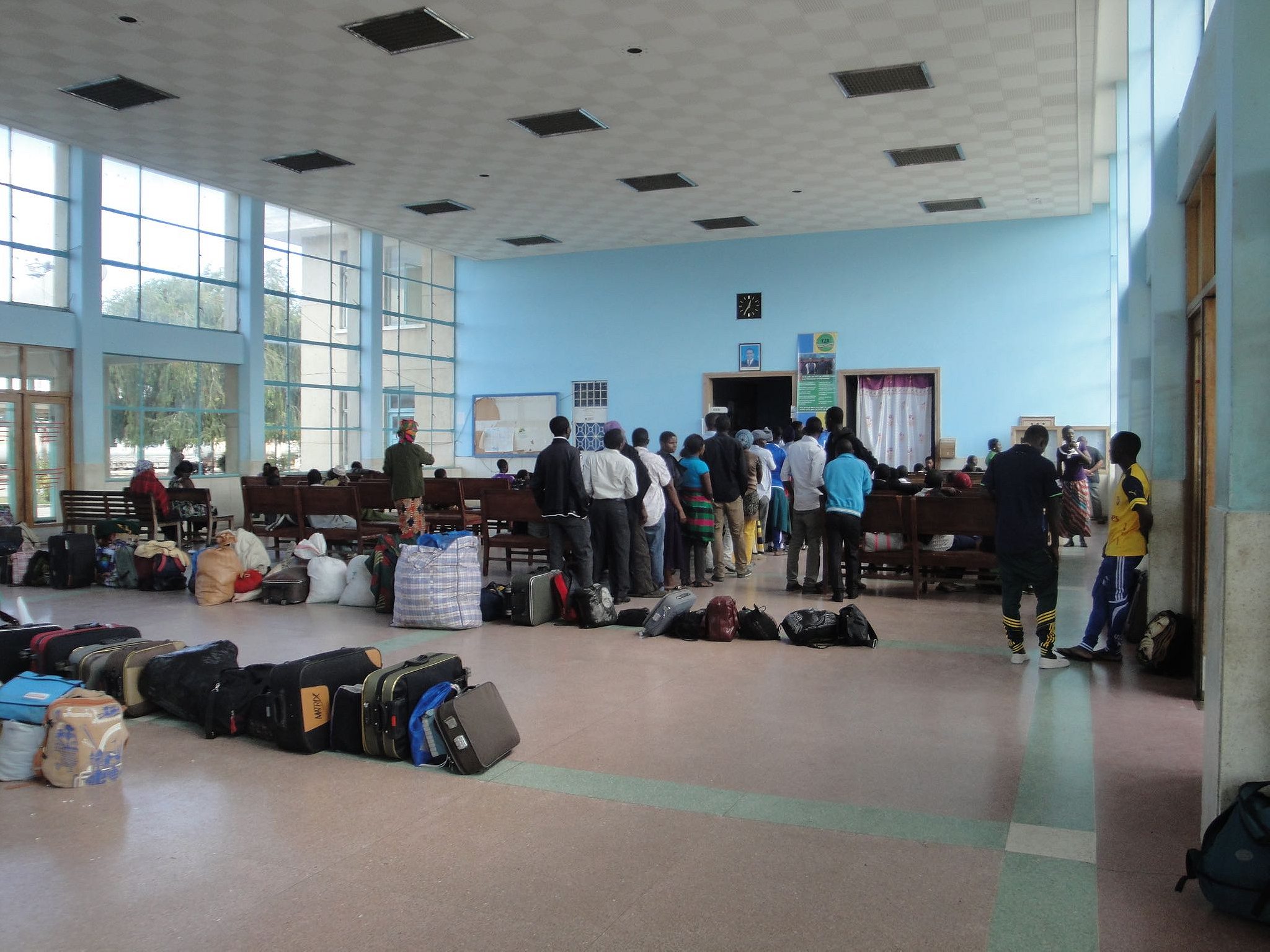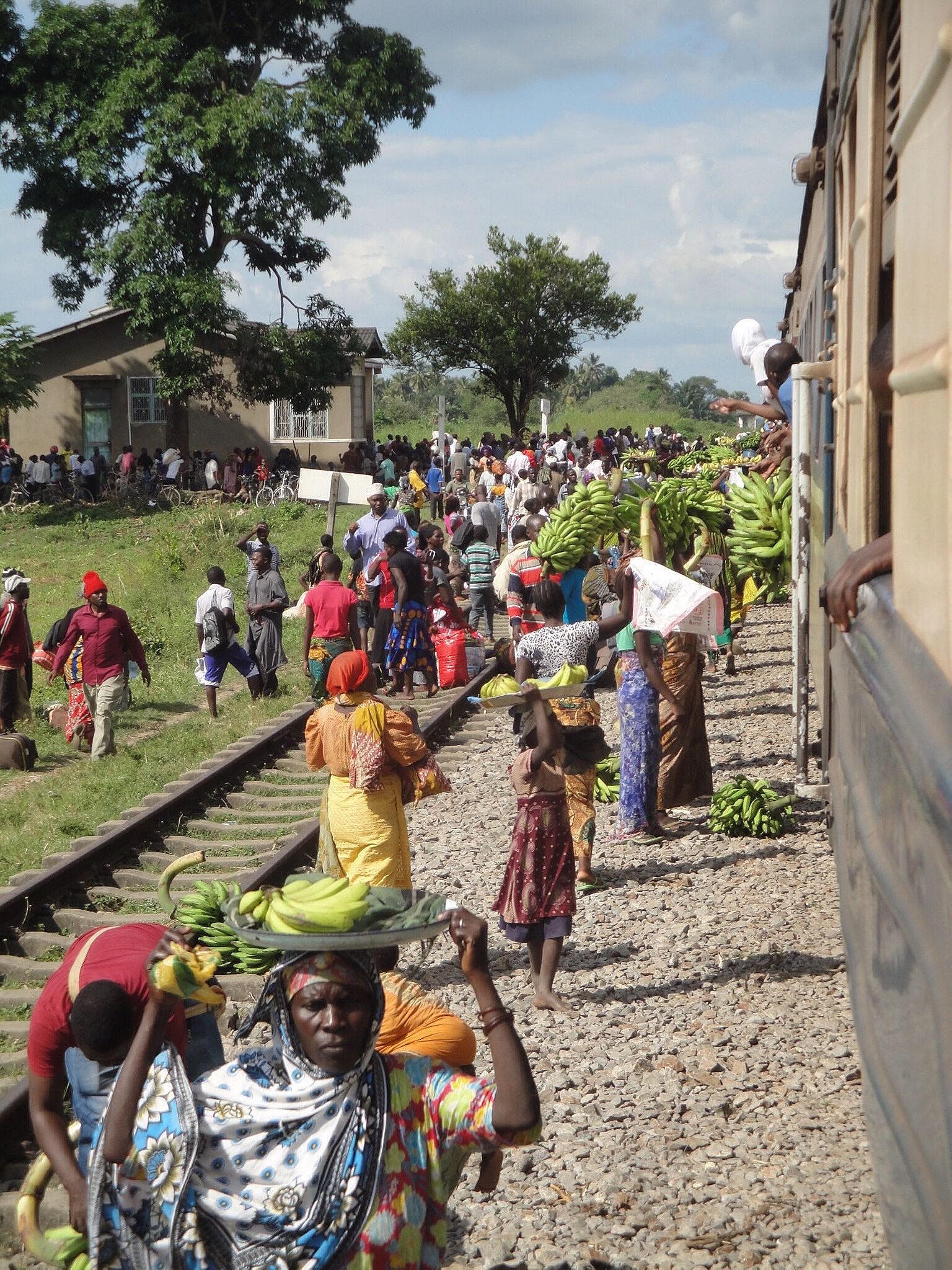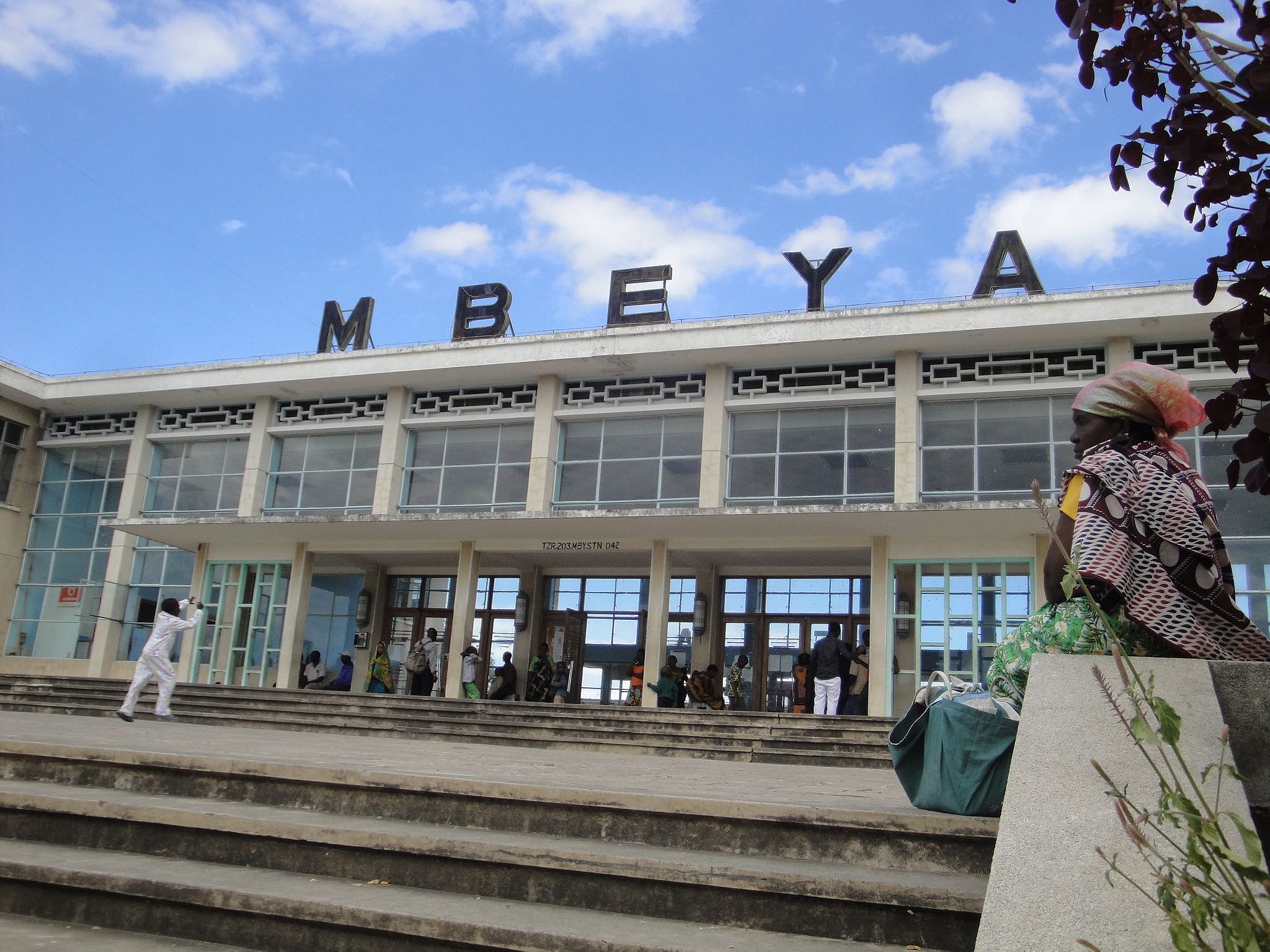Despite millions in investment from China, Tanzania’s rail system is inefficient, expensive, and a pretty good time.
I stand in a neat queue with the rest of the passengers waiting to buy a train ticket from the southwestern Tanzanian city of Mbeya to Dar Es Salaam. My fellow travelers have already placed their suitcases in a series of straight lines inside the station building, a convention I haven’t seen before. I’m not used to this level of orderliness on public transport in this region. I finally get to the front of the queue for the ticket office and ask for a first-class ticket.
The middle-aged man in the ticket office wears a blue, long-sleeved shirt and gold-rimmed glasses perched on the end of his nose. He says he can’t sell me a ticket until he has received a phone call that the train is “on its way.” I think the train started in Kapiri Mposhi in Zambia, so I ask whether he has to wait until it has crossed the border, but he’s already moved on to the next customer. I gain his attention and ask what time I should come back. According to the timetable, the train should be here in forty minutes. “Umm … two hours,” he says.
I return to the ticket office every half hour. Through the crowd I make eye contact with the man behind the counter and he shakes his head solemnly. The sixth time, he gives me an almost imperceptible nod. I smile and he smiles back. Two minutes later I have my ticket.

“What time will the train come?” I ask, my enthusiasm at the prospect of taking my first sub-Saharan African train journey reflected in my voice.
“About two hours,” he says, unconvincingly. I think it’s the brief glance upwards just before he answers. Or maybe it’s his tone: the hopeful yet uncertain tone that contestants use on television game shows when they’re not sure of the answer they’re giving. It doesn’t matter. I have my ticket. I’m guaranteed a bed in first class. Of course, it’s not at all guaranteed that the train will turn up, but for now, I’m content.
The train arrives almost three hours later. The station building is now packed with people. The luggage is lost in a forest of legs that have kicked the ordered lines out of shape. The train stops and passengers disembark. They exit the platform using a gate to the side of the building. Then someone unlocks the double doors that lead to the platform and people surge towards the train.
I’m not sure of the purpose of the lines of luggage. Perhaps the intention was for people to file in line towards the train. But that’s not what happens. There’s cheerful shouting and whooping as young men and a few young women push their way through the bottleneck at the doors and sprint towards the economy coaches, lugging rucksacks and synthetic holdalls behind them. The orderliness has vanished in an instant.
I am taking this train for the views of the landscape and because I think it will provide an interesting glimpse into everyday Tanzanian life. I am initially unsure why many Tanzanians opt for the train in a region of the world where people tend to gravitate towards the cheapest option out of necessity. The cheapest third class tickets, which are the most numerous, offer less comfort than many of the long-distance buses plying the same route, yet cost twice as much. According to the timetable, the train takes eight hours (24 in total) more than the bus to cover the 528 miles between Mbeya and Dar.

I ask the half-dozen Tanzanians I meet during the journey about their reasons for choosing the train. Some claim it is the most convenient way to reach their isolated destination, which would otherwise require multiple buses. One man in first class cites comfort. But the common thread in every answer is safety. Road accidents rank as the second most common cause of death after malaria in Tanzania, and are the number one cause of death of Tanzanian men in their twenties. There is a widespread perception that long-distance buses are frequently involved in fatal crashes; however, a study in the late 1990s found that while dalla-dallas—public minibuses that operate in cities or on short distance routes—were disproportionately involved in accidents, long-distance buses accounted for just 0.3 percent of vehicles involved in accidents.
Accurate or not, this perception of increased safety convinces many rail travelers to put up with long delays and frequent stops. It’s another hour and a half until we’re finally off. I love the gentle, rhythmic sounds of the train on the rails, the occasional metallic clunks and squeaks, and the sharp whistling of the breeze streaming in through the window of our compartment. Gazing out of the window, the landscape transforms from savanna, to farmland, to pastures, forests, and wilderness scrubland, and back again.
I’m lingering on the thought that well-irrigated agricultural land in East Africa looks so lush and fertile when this bucolic harmony is shattered into pieces by the screeching of brakes that cause the entire train to shudder violently every few seconds as it grinds to a halt. On this occasion we appear to have stopped at a station. There is no platform, just two wooden huts and a crowd of about forty people with belongings lining the edge. There’s a larger group of people, too, hoping to sell their produce to the passengers on the train.

Different villages along the track seem to specialize in different foods depending on the soil and climate: sacks of potatoes, sacks of onions, bundles of sugarcane, giant bunches of green plantains, plastic bags of tomatoes, and maize.
“Do you think they will be selling Black Forest gateau at the next village?” asks Wolfgang, a German tourist in his mid-30s with a fashionable haircut and smart clothes.
I’m sharing my four-berth compartment on the train with him and two Tanzanian men in their early-to-mid 40s, John and Adamu. Wolfgang, not for the first time, is fooling around.
“What I would really like is a strawberry cheesecake, or maybe pain au chocolat. Do you think they will sell them at the next village? I’m just not interested in sacks of potatoes.”
Now that John and Adamu have got wise to Wolfgang’s joking, they play along. Adamu—a pudgy man in an olive-green shirt and blue, woolen hat—reassures him that the villagers at the next stop will be selling all manner of delicious cakes and pastries. This is one of Adamu’s rare conversations. Like a cuckoo clock, most of the time he’s silent, but occasionally he’ll come alive for a few minutes before withdrawing into his semi-permanent dozing.
Meanwhile, John negotiates a price for two sacks of potatoes and hoists them through the window into the compartment. “For my family in Dar,” he says, as he slides the sacks under his bed. John worked for this train company five years ago. He says he left because his wages weren’t paid for six months. He sits across from me, reading a manual on mechanical engineering in Chinese script. He tells me he spent three years in China studying and working.
This railway is one of many links between Tanzania and China. It was built in the early 1970s by the Tanzania-Zambia Railway Authority (Tazara) and financed by China to provide a route to the sea for landlocked Zambia’s mining exports. This was at a time when Zambia was governed by a leftist, pan-Africanism government and bordered by hostile, white-governed Namibia, South Africa, and Rhodesia (now Zimbabwe). Tanzania was experimenting with pan-Africanism, too, as well as socialism. Tazara was the most expensive single foreign-aid project undertaken by China when it was launched, and they’ve been closely involved ever since.

The railway was built to transport freight, but freight volumes have declined every year, dropping from 60 percent of port cargo in the 1970s to less than 10 percent today. The network runs at a loss and in 2011, China wrote off approximately 50 percent of Tazara’s debts. It’s difficult to shake the feeling that this railway is something of a white elephant and that the problems run deeper than simply a lack of money (which the company says it needs for upgrading rolling stock and tracks).
While concerns over safety may convince passengers to pay extra and arrive at their destination later, the same cannot be said for those transporting freight, which is, after all, Tazara’s core business. The costs of transporting goods by rail are far higher than they should be, almost the same as via roads. And the rail-freight services are not immune to the delays that affect the passenger trains. In fact, John says, freight trains frequently experience considerably longer delays.
We shudder to a halt again, this time in the countryside with no station or people in sight.
“You know,” Wolfgang says, “if everyone has bought two sacks of potatoes, maybe this is why the train cannot move!” He points to the bags under John’s bed.
John laughs. “They are just changing drivers. They always change drivers here.”
“But we are in the middle of nowhere. There is no station. Where are the people? There are no houses.”
John claims the new driver has not yet turned up; a common occurrence, he insists. I’m no longer sure who is teasing whom anymore.
I’m glad I’m a tourist with time on my hands. If I were responsible for moving freight along this route on a strict deadline, these delays would be an entirely different matter.

There is little mention of efficiency, reliability, and punctuality in the numerous announcements of new transport infrastructure projects in Tanzania. Oman and China are jointly funding an $11 billion USD project to build a large-capacity port north of Dar es Salaam. But despite the World Bank’s estimate that inefficiencies at the current port in Dar result in losses to Tanzania of $2.6 billion every year, there is no mention of what will be done to ensure these inefficiencies will not continue at the new one. The Tanzania Shipping Agents Association claim that the extra capacity offered by the new port is unnecessary and that the money should be spent on upgrading existing facilities at Dar.
In addition to mining and energy projects with Chinese involvement, Tanzania announced that it would spend $14 billion on constructing a new rail network, linking its coast to other landlocked countries in the region besides Zambia, such as eastern Democratic Republic of the Congo, Rwanda, Burundi, and Uganda. These grand projects, with their talk of moving goods seamlessly and efficiently from the Indian Ocean across the country, seem a world away from my experience of the Tazara line.
We have stopped again. Another station, this time for what looks like a small hamlet. Vendors here are selling plantains and sweet yellow bananas. They’re doing a brisk trade. A lone woman is selling passion fruit but I’m reluctant to buy any, as the ones I tasted in a neighboring country were so sour I found them inedible. But John buys three and persuades me to try one. It’s delicious, so I buy a handful. John buys three boiled plantains sliced lengthways and stuffed with slices of tomato. It tastes as boring as it looks. With a huge grin on his face he offers one to Wolfgang: “Black Forest gateau!”
Forty-five minutes later we are on the move. Wolfgang unfolds his printout of the train’s timetable. “It says we were supposed to spend four minutes here.”
I eat another passion fruit and ask Wolfgang when, according to the timetable, we should have arrived in Dar. We were supposed to be there a long time ago.
Wolfgang groans.
John chuckles, “You know, in Dar, there are lots of bakeries. Maybe they will sell your cake.”
He pauses and glances at his watch. “We will arrive … hmmm … maybe two hours.”
I’d almost forgotten he used to work for Tazara.